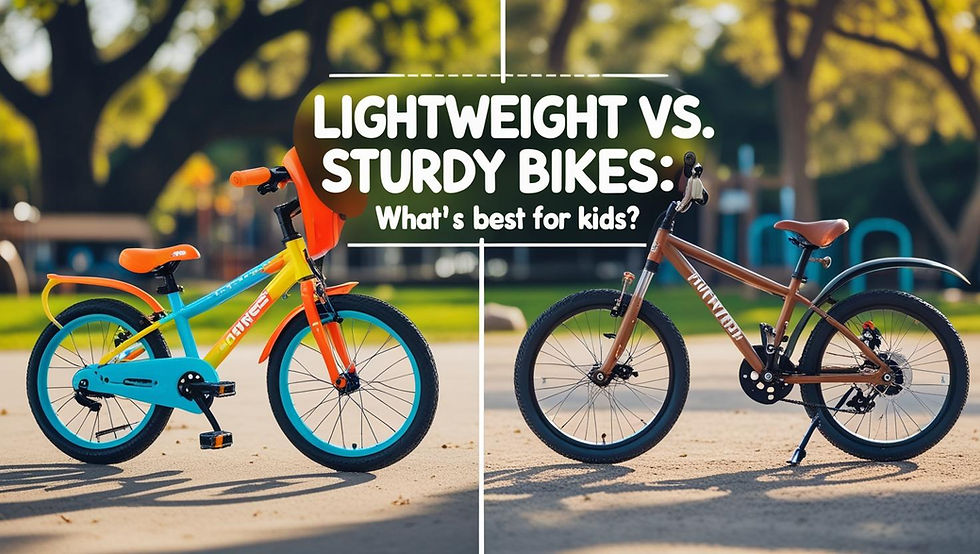Torque, Range, and Wattage: E-Bike Specs Made Simple
- Skilful Sports
- Jun 2
- 3 min read

Electric bikes (e-bikes) are booming in popularity—but buying one can feel overwhelming with all the technical jargon. Terms like torque, wattage, and range pop up everywhere. What do they mean, and how do they affect your ride?
In this guide, we’ll break down these essential e-bike specifications so you can confidently choose the right model for your riding style, terrain, and budget.
What Is Torque in E-Bikes?
🔧 Torque: The Power Behind Every Pedal
Torque measures the rotational force of the e-bike motor and is usually expressed in Newton-meters (Nm). It directly affects how quickly and powerfully your e-bike can accelerate, especially when climbing hills or carrying extra weight.
Low torque (under 40 Nm): Great for flat terrain, lightweight riders, or casual commuting.
Medium torque (40–70 Nm): Ideal for mixed terrain, moderate inclines, and heavier loads.
High torque (70+ Nm): Best for steep hills, off-road trails, and aggressive riding styles.
Example: A mountain e-bike with 85 Nm of torque will feel powerful and responsive on climbs compared to a 35 Nm city cruiser.
Understanding Wattage: What Does It Mean?
⚡ Wattage = Motor Output
Wattage refers to the power output of your e-bike’s motor. Most e-bikes range between 250W and 1000W, though 250W and 500W are the most common for street-legal bikes.
Wattage | Best For | Notes |
250W | City commuting, flat roads | Legal in most regions, great battery efficiency |
500W | Hilly areas, heavier riders | More powerful, can handle moderate inclines |
750W+ | Off-road, adventure, cargo | Higher speeds and torque, may be restricted in some areas |
Important: Check your local laws—some regions cap e-bike wattage to 250W or 500W for road use.
E-Bike Range: How Far Can You Really Go?
🚴♂️ What Impacts Range?
The range of an e-bike is how far it can travel on a single battery charge. It’s affected by several variables:
Battery size (Wh) – Larger batteries (e.g., 500Wh, 750Wh) last longer.
Motor power (W) – Higher wattage consumes more battery.
Riding style – Full-throttle drains battery faster than pedal-assist.
Terrain – Hilly routes reduce range.
Rider weight & cargo – More load = more power used.
Real-World Tip: If a manufacturer claims 80 miles of range, expect 50–60 miles under typical mixed-use conditions.
How These Specs Work Together
Torque, wattage, and range all work together to define your e-bike experience. Here’s how:
A 750W motor with 85Nm torque offers great acceleration and hill climbing, but will consume battery faster.
A 250W motor with 40Nm torque may not climb steep hills well but will offer great efficiency and legal road use.
Spec | City Commuter | Mountain Biker | Casual Rider |
Torque | 30–50 Nm | 70–90 Nm | 40–60 Nm |
Wattage | 250–500W | 500–750W | 250–500W |
Range | 30–60 miles | 20–50 miles | 25–70 miles |
Choosing the Right E-Bike for Your Needs
Here’s how to choose based on your lifestyle:
🚲 For Urban Commuters
Specs: 250W–500W motor, 40–60Nm torque, 50+ mile range
Why: Efficient, quiet, and often legally compliant with road use.
🏞️ For Mountain & Trail Riders
Specs: 750W motor, 70–90Nm torque, 20–50 mile range
Why: You’ll need the torque and power to handle steep gradients and rough terrain.
👵 For Seniors or Casual Riders
Specs: 250W motor, 30–50Nm torque, long range battery
Why: Comfortable riding with moderate assistance, great for leisure use.
E-Bike Spec Sheet: Quick Buyer Checklist
✅ Use this checklist when comparing models:
🔋 Battery capacity (in Wh or Ah)
⚡ Motor wattage (250W, 500W, 750W+)
💪 Torque rating (Nm)
📏 Estimated real-world range
🧠 Motor type (mid-drive vs. hub motor)
🚨 Legal limits in your region
FAQs: E-Bike Specs Explained
What’s more important: torque or wattage?
Both are important, but it depends on your needs. Torque impacts acceleration and hill climbing, while wattage affects top speed and battery drain.
Can I upgrade my e-bike motor?
Not easily. Most e-bikes are designed as integrated systems. Swapping motors may affect your controller, battery, and legal classification.
How can I improve my e-bike range?
Use lower assist levels, keep tires properly inflated, ride efficiently, and avoid aggressive throttling.
Is a higher watt motor always better?
Not necessarily. Higher wattage consumes more power and may be illegal for road use in some areas.
How do I know the real range of an e-bike?
Subtract about 20–30% from the manufacturer's estimate for a more realistic range.
Conclusion: Know Your Specs, Ride Smarter
Understanding the trio of torque, wattage, and range is essential for choosing the right e-bike. Whether you're commuting, riding trails, or just cruising, knowing how these specs work together helps you make a smarter, longer-lasting investment.
👉 Ready to explore top-rated E-bikes?
Browse our latest collection of performance-driven E-Bikes on Skilful Sports



Comments